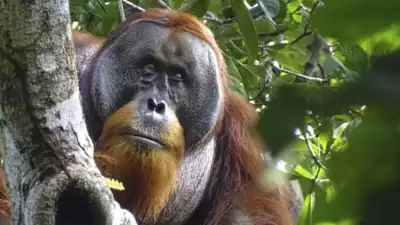Free Courses Sale ends Soon, Get It Now


Free Courses Sale ends Soon, Get It Now



Disclaimer: Copyright infringement is not intended
Context:
Details
Self-medication in Non-humans
About akar kuning or yellow root
|
About Orangatuans |
|
|
Taxonomy and Classification |
●Orangutans are great apes belonging to the family Hominidae and genus Pongo. ●They are classified into two species: the Bornean orangutan (Pongo pygmaeus) and the Sumatran orangutan (Pongo abelii). ●Bornean Orangutan (Pongo pygmaeus): ○Bornean orangutans are native to the island of Borneo in Southeast Asia. ○They have a broader distribution compared to Sumatran orangutans, inhabiting both lowland and swamp forests as well as mountainous regions. ○Bornean orangutans exhibit greater dietary flexibility, consuming a wider variety of foods, including fruits, leaves, bark, insects, and sometimes small vertebrates. ○Adult males typically develop larger cheek pads or flanges compared to Sumatran orangutans. ●Sumatran Orangutan (Pongo abelii): ○Sumatran orangutans are found on the Indonesian island of Sumatra. ○They primarily inhabit lowland tropical rainforests, with some populations also occurring in montane forests at higher elevations. ○Sumatran orangutans have a more restricted distribution compared to Bornean orangutans, and they are considered to be more critically endangered. ○They tend to have longer faces and lighter hair compared to Bornean orangutans. ○Sumatran orangutans have a slower reproductive rate compared to their Bornean counterparts.
|
|
Physical Characteristics |
●Orangutans are characterized by their shaggy red fur, long arms, and a bulky body. ●Adult males develop large cheek pads known as flanges, which are fully developed in dominant males. |
|
Habitat and Distribution |
●Orangutans are native to the rainforests of Borneo and Sumatra in Southeast Asia. ●They inhabit lowland and swamp forests as well as mountainous regions. |
|
Behavior and Social Structure |
●Orangutans are primarily solitary animals, with adult males being largely solitary while females may occasionally interact with other individuals. ●They are arboreal, spending most of their time in trees, and are well adapted for swinging and climbing. |
|
Diet and Feeding Habits |
●Orangutans are primarily frugivorous, with fruits making up the majority of their diet. ●They also consume leaves, bark, insects, and occasionally small vertebrates. |
|
Reproduction and Life Cycle |
●Female orangutans give birth to a single offspring after a gestation period of approximately 8.5 months. ●Offspring stay with their mothers for several years, learning essential skills for survival before becoming independent. |
|
Conservation Status |
●Orangutans are listed as critically endangered by the International Union for Conservation of Nature (IUCN). |
|
Threats |
●Habitat loss due to deforestation, illegal logging, and palm oil plantations pose significant threats to their survival. ●Hunting and poaching also contribute to their declining population. |
Source:
|
PRACTICE QUESTION Q. Consider the following statements about Orangatuans:
How many of the above statement is/are correct? A.Only one B.Only two C. All Three D.None Answer: A Explanation: Statement 1 is incorrect: Orangutans belong to the genus Pongo, which is one of the three genera in the family Hominidae (the great apes). Orangutans are often referred to as "great apes," along with chimpanzees, bonobos, gorillas, and humans. Statement 2 is correct: Bornean orangutans indeed have a broader distribution compared to Sumatran orangutans. They inhabit a wider range of habitats, including lowland and swamp forests as well as mountainous regions, whereas Sumatran orangutans are primarily found in lowland tropical rainforests. Statement 3 is not correct: Orangutans, both Bornean and Sumatran, are not categorized as "Endangered" but rather as "Critically Endangered" by the IUCN. This designation reflects the severe threats they face due to habitat loss, illegal hunting, and the illegal pet trade. |
© 2024 iasgyan. All right reserved